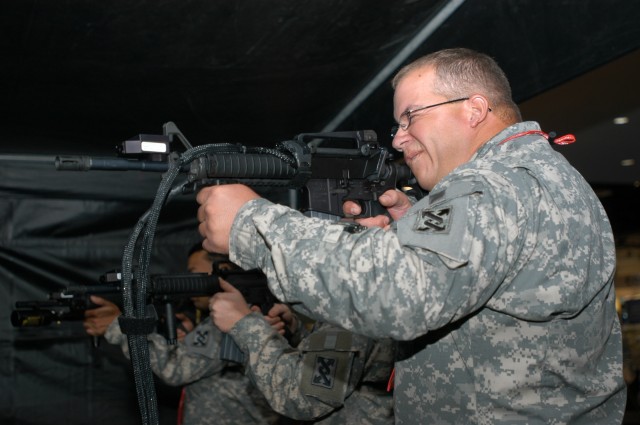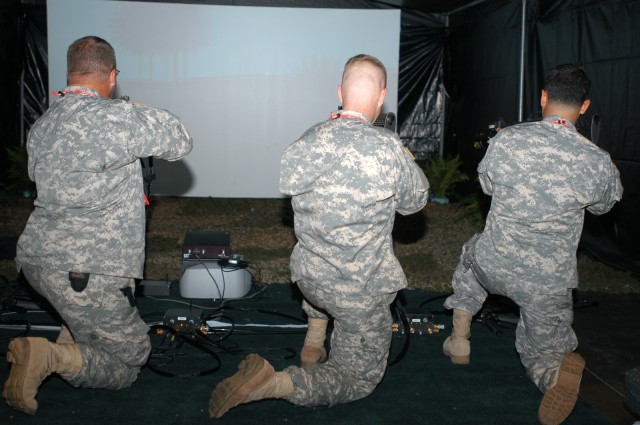ORLANDO, Fla. (Army News Service, Nov. 29, 2007) - Army Reserve Soldiers gained experience on simulators this week as several commands showcased their technologies at the Interservice/Industry Training, Simulation and Education Conference in the Orlando Convention Center.
The conference promotes cooperation between the armed forces, government, the defense industry and academia to improve training and education programs and identify common training issues.
The video game "America's Army," is being run at the conference on terminials set up by the Aviation and Missile Research, Development and Engineering Center, headquartered at Redstone Arsenal, Ala.
HapMed, a game-based simulation training system designed to support combat medics, complete with maniken parts, is being displayed at the confernce by the Army's Simulation and Training Technology Center in Orlando. STTC is also featuring the Tactical Digital Hologram, which addresses the need for visualization tools that provide a bridge between complex battlefield imagery data to Soldiers for mission planning, operations and debriefs.
Future Combat System requirements are being addressed through the Crew-Integration and Automation Testbed. The CAT ATD has advanced vehicle crew stations that test two- and three-man crews. It was brought the convention by the Tank, Automotive Research, Development and Engineering Center in the Detroit Arsenal, Warren, Mich. TARDEC, STTC and AMRDEC are all part of the U.S. Army Research, Development and Engineering Command, headquarterd at Aberdeen Proving Ground, Md.
Soldiers from the 143rd Sustainment Command (Expeditionary), an Army Reserve unit, partnered with the Army's Program Executive Office for Simulation, Training and Instrumentation to support the conference.
PEO STRI provides interoperable training and testing solutions and program management as well as life-cycle support for the Army's advanced training systems.
The 143rd ESC commands and controls units, provides logistical planning and support operations and provides combat service support forces capable of supporting full-spectrum logistics.
A key element of the demonstration was a simulated Humvee rollover, which allowed the 16 Soldiers, all from the 196th Transportation Company, to practice extricating themselves and wounded comrades from damaged vehicles.
"We want to take advantage of doing some training as well as supporting," Sgt. 1st Class Michael Segreaves said. "Repetition in demonstrating this stuff has its benefits. Being upside down and extracting yourself from a vehicle - there are hardly any opportunities to get this type of training, and I/ITSEC provides this opportunity. We know Soldiers are getting killed this way."
"This is really good training," Sgt. Laura Jordan said. Ordinarily she drives a palletized-loading system truck, but she insists the training is still beneficial. "It gives you the idea of what it is really like."
About 100 feet from the rollover simulator, three Soldiers patrolled an Iraqi street simulated on a large color screen. As the Soldiers moved through the streets carrying M-4 rifles, a rooftop sniper began firing at them. Firing at the screen, they killed the sniper as villagers scrambled on the streets below.
The simulator is an extension of the Army's marksmanship training program, but it added non-combatants, an urban environment and other Soldiers involved in the mission.
"This does help with unit cohesion," Staff Sgt. Scott Zeman said after he and two other Soldiers encountered the ambush, noting that the rifle's recoil was realistic. His teammates added that not only did the simulator help prepare them for the frontlines, it taught them to communicate with each other during hostile actions.
Another popular simulator was the Stryker, which consisted of a vehicle cab, instructor-operator system, a visual system and freedom-motion system, all linked by computer.
The instructor selects visual and mechanical scenarios and monitors and scores each driver trainee. The instructor can introduce malfunctions and emergencies in both tactical and non-tactical environments.
"It feels real - the movement - especially when off-roading; the bouncing seems so real," said Spc. Richard Abreu. He served as a scout in Iraq with the 2nd Armored Cavalry Regiment and believes simulators would help those entering vehicular professions.
"It would be good for people just coming into the military," he said. "Giving them something like this to train in would be real good so they're more comfortable."
Master Sgt. Daniel Lopez agreed that simulator training for new Soldiers would be beneficial. He has been involved in rollover accidents and knows the value of simulators firsthand because vehicles do not get damaged and Soldiers do not get injured.
He said the simulators can indoctrinate Soldiers into various conditions. Desert, mountain and snowy environments can all be trained from one location when the simulator is programmed accordingly.
"It's high speed," he said, adding that he planned to have his Soldiers go through the simulators all night long.
For his first try behind the wheel of the Stryker simulator, Master Sgt. Lopez asked his instructor to introduce 100 mph winds into his scenario, as well as snow and hills.
"I was trying to drive up a hill and didn't give it enough power and I started to slide back down the hill," Master Sgt. Lopez said with a smile. "I also overcorrected with the wind."
By the third day of the conference the Soldiers had gone through the simulators so many times they had lost count, but all of them were glad they had the opportunity to participate in the conference.
(Capt. Alvarez is the public affairs officer for the 143rd ESC. Andricka Thomas writes for the U.S. Army Research, Development and Engineering Command at Aberdeen Proving Ground, Md.)




Social Sharing